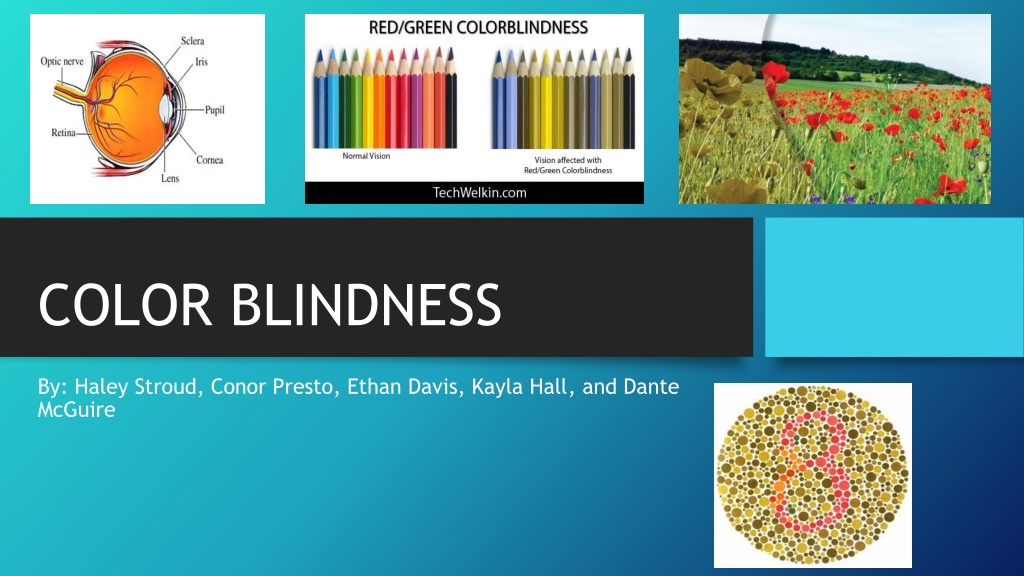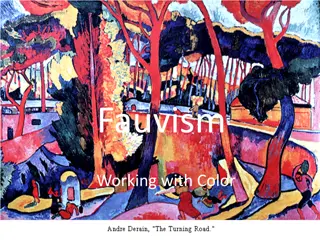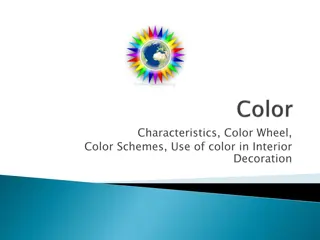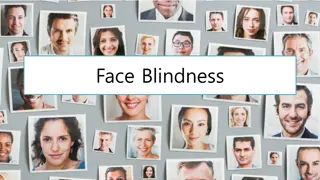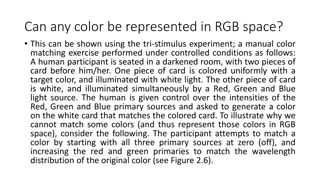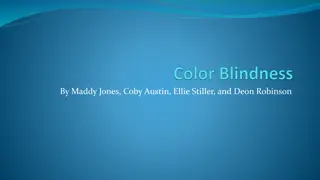Understanding Color Blindness: Causes, Symptoms, and Types
Color blindness, also known as color vision deficiency, is a genetic disorder that affects the ability to distinguish between certain colors. It is caused by the absence of color-sensitive pigment in cone cells of the retina, often passed down on the X chromosome. Symptoms vary from difficulty differentiating colors to total color blindness. There are different types of color blindness, such as Protanomaly, Deuteranomaly, and Tritanomaly, each affecting sensitivity to different colors. Understanding the causes and symptoms of color blindness is crucial for early detection and management.
Download Presentation

Please find below an Image/Link to download the presentation.
The content on the website is provided AS IS for your information and personal use only. It may not be sold, licensed, or shared on other websites without obtaining consent from the author. Download presentation by click this link. If you encounter any issues during the download, it is possible that the publisher has removed the file from their server.
E N D
Presentation Transcript
COLOR BLINDNESS By: Haley Stroud, Conor Presto, Ethan Davis, Kayla Hall, , and Dante McGuire
Color Blindness Also known as color vision deficiency, Daltonism,and Poor color vision. The name Color Blindness was chosen because people with this condition can t distinguish certain shades of color making them blind to color. This name is actually misleading because very few people are actually colorblind. This is why color vision deficiency describes it better. In 1794 at the Department of Molecular Genetics, University of London John Dalton described his own Color Blindness. Both John Dalton and his brother confused red with green and pink with blue. Dalton supposed that his vitreous humor was blue but they were perfectly clear. Dalton was a deuteranope and lacked the middle wave photopigment of the retina.
Type of genetic disorder Color Blindness is the inability to distinguish the difference between some colors. It is the result of an absence of color sensitive pigment in the cone cells of the retina. Color Blindness is passed down on the X chromosome. Chromosomes contain genes which have the instructions for the development of cells tissues, and organs. If you are colorblind it means the instructions for the development of your cone cells are faulty. This means they can be missing, less sensitive to light, or the pathway from your cone cells to your brain may not be developed
Symptoms of Color Blindness Part 1 The person may not be able to differentiate red and green colors, or the blue and yellow colors Sometimes, in less severe cases, the person is simply not able to see or distinguish the shades of any color People who suffer from total color blindness may not be able to see any colors except for black, white and gray Not being able to see the brightness of colors is also an important color blindness symptom
Symptoms of Color Blindness Part 2 There are 3 types of color blindness, Protanomaly, Deuteranomaly, and tritanomaly. Protanomaly is reduced sensitivity to red light Deuteranomaly is reduced sensitivity to green light and is the most common. Tritanomaly is reduced sensitivity to blue light which is the rarest form.
Symptoms of Color Blindness Part 3 People with Protanomaly confuse: black with red, dark brown with dark green, dark orange with dark red, blues with reds, purple with dark pinks, mid-green with oranges. People who have Deuteranomaly confuse: mid-red with mid-green, blue-green with gray, pale pinks with dark grey, mid-reds with mid- green, and light-blue with lilac People who have tritanomaly confuse: blue with grey, purple with black, green with blue, and orange with red. COMPETITION what competition lol lol lol meme lord potato nudes
Effects of the Disorder You will not be able to see some colors Other colors will appear a different color You cannot tell the difference between some foods/sauces/ingredients Harder to drive Extremely hard for primary students because of the color teachings Color blind people can see colors, but some colors fade into black and white or different colors If you have a 36 pack of colored pencils you could only see 12 of them
Diagnosis of Disorder Color-blindness can be difficult to detect Some children don t believe they have problems with color vision Eye doctors (Optometrists) should check you on routine for color issues Most common test is the Ishihara Plate Test More sophisticated tests like the Lantern Test see if colorblind people can still apply for certain jobs where you need to accurately be able to identify colors (ex: train drivers, marine, or aviation jobs).
Color Blindness Impact Part 1 Does not impact life expectancy directly. EX: A person that is color blind is expected to live a normal length life, but if they cannot tell which color is which at a stop light they can be killed in a crash. Limited: Can t tell difference between some colors. Most commonly inherited is Deuteranopia (red & green) where they can t tell the difference between red & green. Can impact you physically. Can affect certain jobs you can have. EX: Piloting an airplane.
Colorblindness impact Part 2 Can impact health by not telling if food is good or not Can impact family mentally if a family member with it was injured due to accidents. Might have family members constantly help them.
Color Blind Treatments No current medical treatment has been created to cure the disorder or symptoms of the disorder Some color filters and contact lenses, however, have been created to give people with the disorder normal vision These lenses and filters also have side effects, like further confusion No treatments have been used in any time period Gene therapy is a possibility that scientists are currently looking forward to in the future
The PHG Foundation The PHG Foundation works to fight against diseases like color blindness. The PHG Foundation has been able to cure red-green color blindness in adult monkeys. They believe that that being able to cure color blindness in monkeys could carry over to humans and help find a cure to stop color blindness.
Color Blindness Graphic http://www.youtube.com/watch?v=gRfJz9boH10
Peter Milton Peter Milton is a 32 year old Art teacher at the Maryland Institute College of Art in Baltimore and a painter, when he was diagnosed with Deuteranopia (red-green colorblindness). Milton then abandoned color and embraced black and white in his paintings, and focused more on detail, rather than color. He claims that he doesn t miss color and that differences in vision are of no importance. One of Milton s artworks-
Works Cited Evancie, Angela. "For One Artist, Colorblindness Opened Up A World Of Black And White." Npr. Vermont Public Radio, 14 Nov. 2014. Web. 5 Apr. 2016. Lusby, Franklin W., MD Ophthalmologist. "Color Blindness." Medline Plus. Lusby Vision Institute, 5 Nov. 2015. Web. 4 Apr. 2016. Hunt, DM, Dulai, KS, Bowmaker, JK, and Mollon, JD. "The Chemistry of John Dalton's Color Blindness." The Chemistry of John Dalton's Color Blindness. - PubMed - NCBI. Department of Molecular Genetics, University of London, UK, 17 Feb. 1995. Web. 4 Apr. 2016. Pruthi, Sandhya, MD. "Poor Color Vision." Mayo Clinic. Mayo Clinic, 13 Feb. 2014. Web. 4 Apr. 2016. Colblindor. Terminology of Color Blindness. Colblindor. WordPress, 9 Feb. 2007. Web. 4 Apr. 2016.
